Scratch Pringles Flyer Original Design / Scratch Built
Scratch - Pringles Flyer {Scratch}
Contributed by Mark Van Luvender
| Manufacturer: | Scratch |
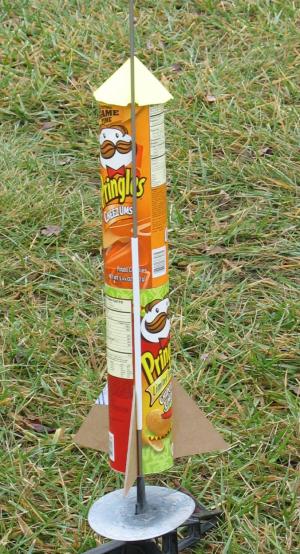
Brief:
The Pringles Flyer is a single staged scratch built rocket built entirely from recycled materials. It contains a
single 24mm motor mount, and a parachute recovery
Construction:
Household parts needed:
- 3 Pringles cans, top and bottom bands (metal parts) cut out.
- 1 sheet VERY THICK card stock from the back of a note pad
- 1 sheet thinner card stock from the back of a different note pad
- 1 metal strip from windshield wiper blade
- 1 sheet thin card stock from wife's scrapbooking stash (shhhhh!)
- Elastic from wife's sewing stash (shhhh!!!)
- mylar balloon
- kite string
- Drinking straw
This build is fairly simple and straightforward. First, cut centering rings from the thinner card stock. I cut three, then glued two together for the forward centering ring. Use the metal strip to make a motor hook, and incorporate the hook into the centering rings, as this rocket has no motor tube. I used JB weld to hold the hook in place in the centering rings to make sure it does not break free from the rings under thrust of the D motor. Basically, I took the metal strip, bent the top for the top of the hook, then fed it through slots cut in the CRs, then marked the length needed by measuring against a motor, then bent and cut the bottom of the hook. It was then JB welded, and set to dry.
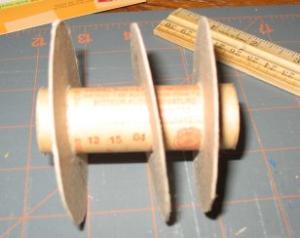
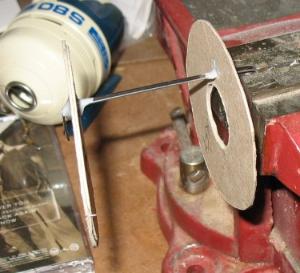
While the motor mount was drying, I cut the fins. These were basic triangular shapes cut from the very thick (roughly 1/8" thick) card stock. Once the fins were cut, it was on to the body tubes. The body consists of Pringles cans held together with a coupler cut from the third Pringles can. To make the coupler, cut a 4 inch section from the Pringles can, and peel the label from the outside. Next, cut a slit down the side of the tube. Slide one end of the cut inside the tube and glue together to create the coupler (see picture for better details). To get the glue to stick, cut cross hatches in the foil liner to let the glue soak in and stick the coupler together. Make two of these couplers - one will be used for the nose cone. Once the coupler is set, glue it to one tube. Once set, attach the other Pringles can to create the body tube.
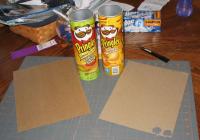
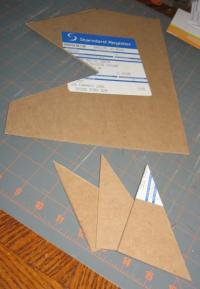
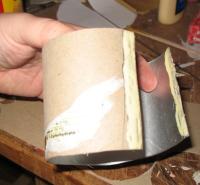
Once the body tube is done, insert and glue the motor mount in place, then mark the Pringles can every 120 degrees for fin attachment. Cross hatch the can with a razor blade to allow the glue to penetrate and attach the fins.
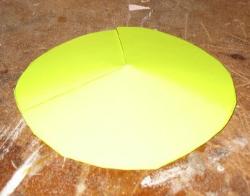 Next is the nose cone. Cut a circle out of the card stock and slit the circle from the center all the way
out to one end. Pull one end of the circle under the other and keep pulling until the nose cone is the desired
shape/size, then glue together. Once the cone is set, center the other coupler in the cone, and glue. My cone overhung
the body tube a bit, so I had to cut a small circle in the overhang to allow the launch rod to pass through.
Next is the nose cone. Cut a circle out of the card stock and slit the circle from the center all the way
out to one end. Pull one end of the circle under the other and keep pulling until the nose cone is the desired
shape/size, then glue together. Once the cone is set, center the other coupler in the cone, and glue. My cone overhung
the body tube a bit, so I had to cut a small circle in the overhang to allow the launch rod to pass through.
Place the straw against a fin/body joint, and glue in place for the launch lug.
Use a piece of paper to make two Estes style tri-fold shock cord mounts and use these to mount the sewing elastic to the nose cone and the body tubes as the shock cord.
Use a plastic parachute as a template to cut a parachute of of the mylar balloon, and use the kite string for shroud lines, and attach to the shock cord.
I needed to add nose weight for stability so 4 spent 18mm motors were glued in to the nose cone coupler for nose weight.
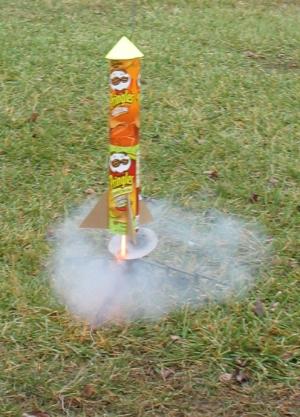 Flight:
Flight:
I was nervous about flying this rocket, but we all have to do things we're nervous about from time to time. Out to a
wet/muddy/snowy field we went. I used dog barf wadding, prepped the recovery, then inserted a D12-3 (not the most
aerodynamic thing...) and placed it on the pad. The launch button was pushed, and the Pringles can lifted arrow
straight into the cloud covered sky. Beautiful flight! Three second delay seemed just about right...maybe a touch
early, but a 5 would be late. Parachute deployed, and it floated down to a nice landing about 5 feet behind me. One of
the fins came off, sticking in the ground. Out came the super glue - fin went back on, prepped for second flight, and
another beautiful flight and recovery! Prepped another D12-3, and away we went. Streaks off the pad, and the fin that
came off on the first flight parted with the body tube as it left the rod. The rocket was still surprisingly stable -
heading up with a bit of a corkscrew flight, but pretty good considering it only had two fins! Parachute comes out,
and it drifts a bit in the slight breeze, landing in the tennis court behind us, taking another fin off.
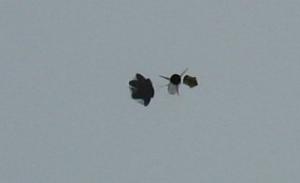
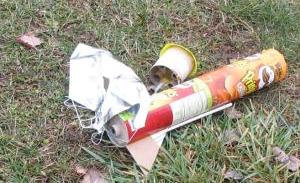
Summary:
This rocket is really fun, and a beautiful flyer! I think I just need to use some stronger attachment methods for the
fins, and we've got a winner!
 |
 |